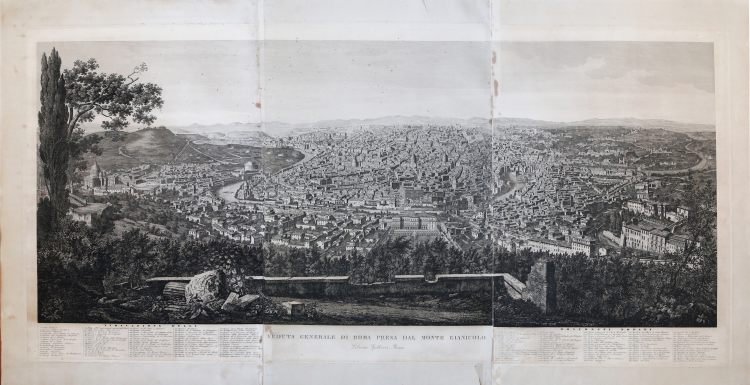



| Reference: | S40629 |
| Author | Tommaso CUCCIONI |
| Year: | 1860 ca. |
| Zone: | Rome |
| Printed: | Rome |
| Measures: | 1580 x 740 mm |


| Reference: | S40629 |
| Author | Tommaso CUCCIONI |
| Year: | 1860 ca. |
| Zone: | Rome |
| Printed: | Rome |
| Measures: | 1580 x 740 mm |
- THIRD STATE with the imprint of the Spithöver Bookshop -
Third state, of the famous panorama from the Janiculum Hill that is attributed to the hand of Lugi Nisi-Cavalieri (Rome XIX sec.) and Augusto Marchetti (Forli 1813 - Rome 1871) for the publisher Tommaso Cuccioni.
Barbara Jatta writes: "The work is not mentioned by the common repertories and the lack of inscriptions leads us to formulate only attributive hypotheses. It is known a copy of the work (Rome, BASA) that indicates as publisher, and client, Tommaso Cuccioni, active in Rome, via Condotti n. 18. We also know of him a small panorama of the city that, perfectly corresponding to this one, even if of very small dimensions, bears the indications "A. Marchetti inc. il paesaggio L. Nisi-Cavalieri inc. il Panorama". It seems therefore possible, considering the correspondence between the two engravers, that also the present one is to be traced back to the same authors. [...] Cuccioni was also one of the first and most famous Roman photographers of the nineteenth century. [...] The panorama of Rome from the Janiculum Hill exhibited here has without doubt a close relationship with the beginnings of photographic technique. Carried out with etching and burin, it owes its basic approach to the use of mechanical instruments". (cf. Barbara Jatta in Roma Veduta, p. 230).
Therefore, if the attribution to Nisi-Cavalieri and Marchetti is, although plausible, purely conjectured, the commission of Tommaso Cuccioni is certain. A fact that leads us to indicate him, as publisher, commissioner and photographer, as the main author of this view.
Of the great view there is a proof, before most of the burin retouches, which we can consider a first state of the plate. The final issue, with the engraving additions, bears the imprint ""Si trova vendibile presso l'Editore Tommaso Cuccioni, Negoziante di Stampe. Roma, Via della Croce n. 88".
The address of via della Croce 88 also puts in doubt the dating assigned by Barbara Jatta to the work (about 1848) that could be therefore also previous. In accordance with her biographical notes in fact (see Marina Miraglia - Dizionario Biografico degli Italiani - Volume 31, 1985) Cuccioni is described already active at the address of Via Condotti 18 before the death of Pope Gregory XVI (1846). A dating around 1840, seems to us more compatible with the biographical notes.
The third issue of the work - which we present here - bears the imprint of the Libreria Spithöver and can probably be dated after 1864, the year of Cuccioni's death.
Josef Spithöver (Sendenhorst, 11 oct. 1813 - Rome, 12 Jan. 1892), born in Germany, was an animator of Roman culture in the mid-nineteenth century, managing a bookshop-publishing house. He was also a pioneer of photography.
Etching and engraving, printed on three sheets of paper datable to the second half of the nineteenth century, widespread burnishing, scattered stains and oxidations, tears in the white margin, otherwise in good condition.
|
Roma Veduta, p. 230, n. 72; Marigliani p. 364, n. 298.
|
Tommaso CUCCIONI (Roma, 1790 circa – 23 agosto 1864)
|
He is one of the first and most renowned Roman photographers of the nineteenth century whose date of death (1864), but not his date of birth. His initial activity, however, was that of engraver and chalcographer, devoting himself to the trade of prints, with a store first in Via della Croce, n. 88, and then in Via Condotti, n. 18, as can be seen from the repertoires of the time of Gregory XVI who indicate him as a dealer of prints, paintings and fine art objects. In the Forties, together with the sale of chalcographic prints, he also began the sale of daguerreotypes and calotypes that he did not yet execute personally, but he commissioned to other Roman professionals of the origins and especially to G. Caneva, his great friend. Only after 1851, that is after the finalization of the wet collodion process, Cuccioni began his new and very lucky career as a photographer because only then, and not before, photography really set itself as an alternative means - with respect to the other reproductive techniques of the past - in the field of image production and reproduction.
Translated with www.DeepL.com/Translator (free version)
|
|
Roma Veduta, p. 230, n. 72; Marigliani p. 364, n. 298.
|
Tommaso CUCCIONI (Roma, 1790 circa – 23 agosto 1864)
|
He is one of the first and most renowned Roman photographers of the nineteenth century whose date of death (1864), but not his date of birth. His initial activity, however, was that of engraver and chalcographer, devoting himself to the trade of prints, with a store first in Via della Croce, n. 88, and then in Via Condotti, n. 18, as can be seen from the repertoires of the time of Gregory XVI who indicate him as a dealer of prints, paintings and fine art objects. In the Forties, together with the sale of chalcographic prints, he also began the sale of daguerreotypes and calotypes that he did not yet execute personally, but he commissioned to other Roman professionals of the origins and especially to G. Caneva, his great friend. Only after 1851, that is after the finalization of the wet collodion process, Cuccioni began his new and very lucky career as a photographer because only then, and not before, photography really set itself as an alternative means - with respect to the other reproductive techniques of the past - in the field of image production and reproduction.
Translated with www.DeepL.com/Translator (free version)
|